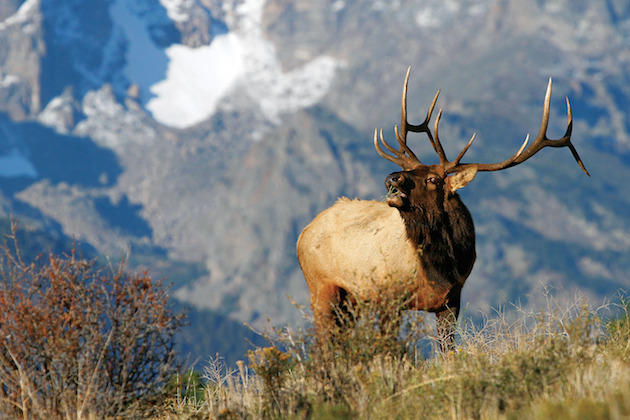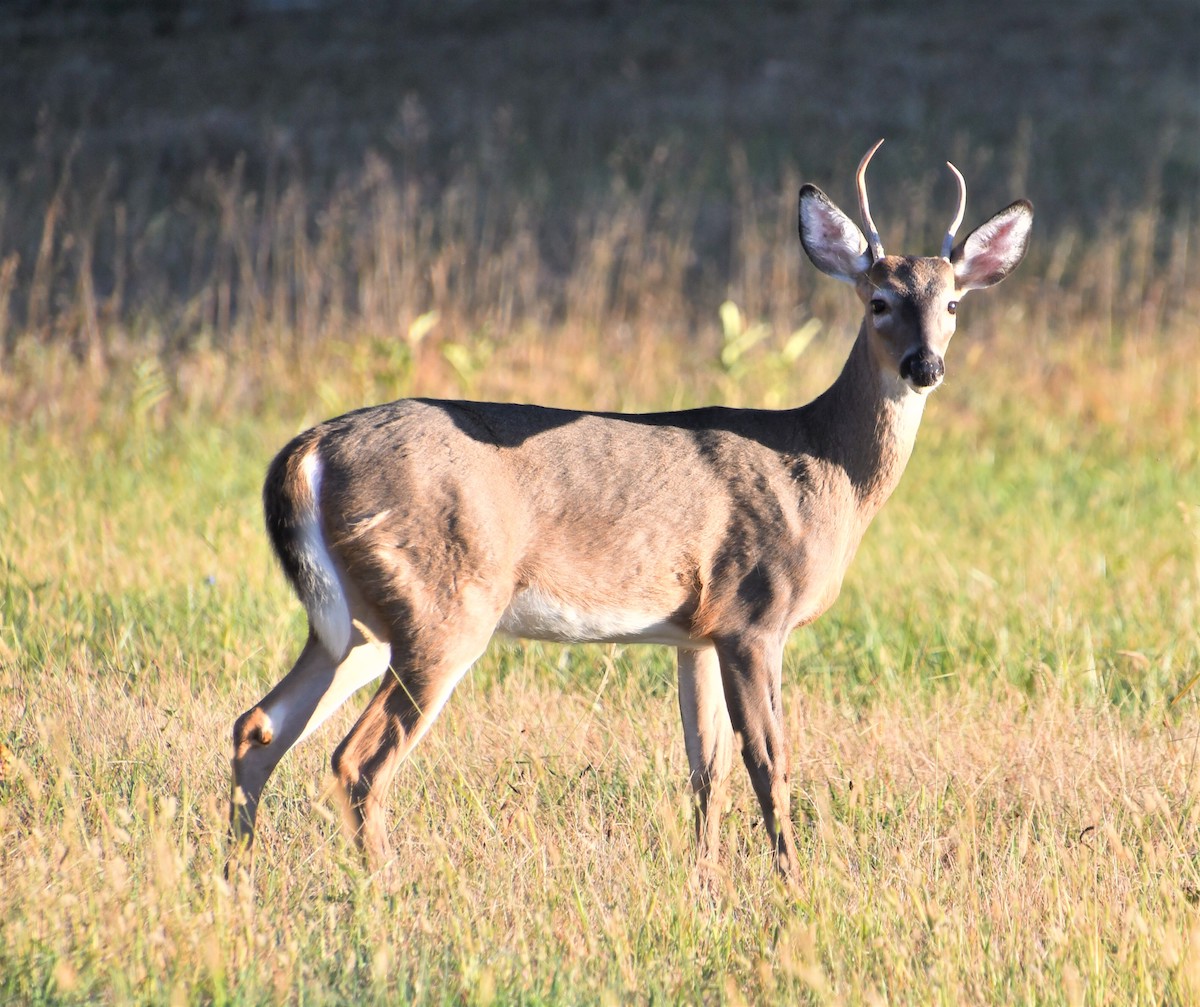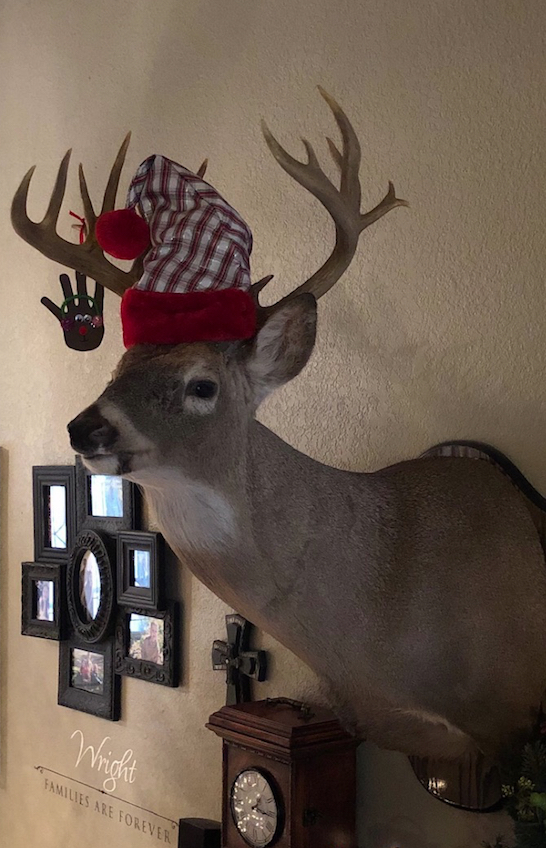For many hunters, elk is the biggest of big game and the most difficult hunt they will ever attempt.
From the May/June 2015 issue of Sporting Classics
My wife, Kellie, is aggravatingly fond of claiming that I married her for her cooking. That is not true, although she certainly knows how to get around in the kitchen. Her dowry was an elk-hunting father, and marriage virtually guaranteed an invite to the camp he pitched each fall. The plan worked better than I had a right to imagine.
One opening morning I followed him to the head of a canyon in Washington’s Blue Mountains. We waited under a big pine and with the daylight came elk, including the first bull I had ever seen. We shot, shot some more, and then kept shooting until the bull went down. Even 30 years later that young five-by-six remains one of my most valued trophies.
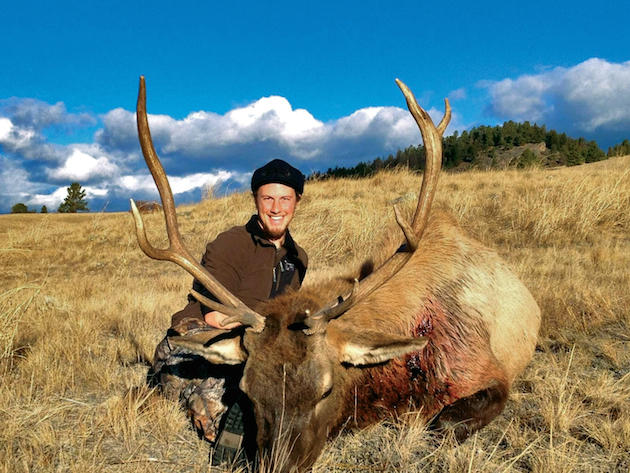
The author’s son, Ross, sorted this bull from a herd pushed his way by another hunting party.
Elk hunting is something of a paradox. Many who live in the West hunt elk every year, spend little in the process, and consider doing just that a right of birth. Tens of thousands of nonresidents do pretty much the same thing, although their tags cost more and their drive to elk country may stretch through one or two nights each way.
Today, most elk hunters go afield with a general-season tag in their pocket. Residents usually buy them over the counter and nonresidents enjoy pretty good odds of drawing them. While every state is a little different, including Colorado where even nonresidents are still welcome to buy over the counter, these tags usually let archery hunters hit the mountains during the rut and restrict rifle hunters to later in the fall.
My son, Ross, has been my elk-hunting partner since he was born. We live in Montana where buying an elk tag is nothing short of a moral obligation, and the year he turned 14 we threw in with a guy down the road who had a wonderful problem. A herd of about 60 elk had developed the habit of feeding in his huge peppermint field. He had never shot an elk and asked us for some help. Being neighborly, we agreed.
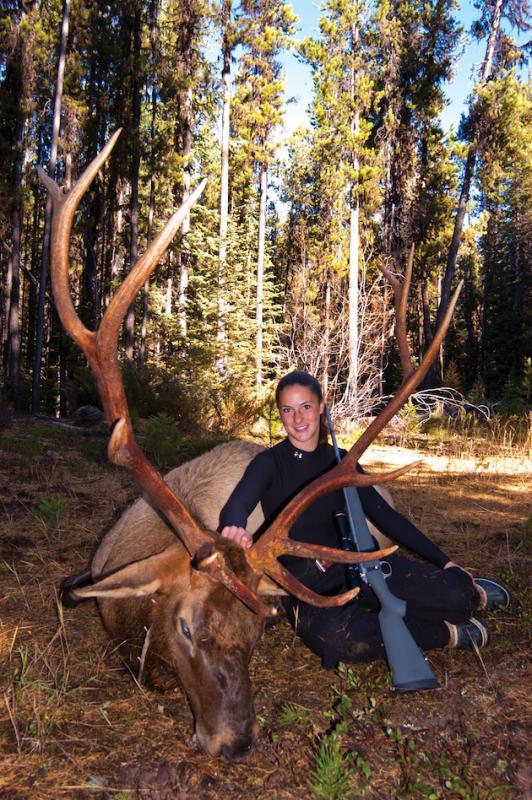
The author’s daughter Keni took her first bull, a great one at that, when she was just 15.
Along with the landowner and his two sons, we began watching the herd in early September. As shooting distance was likely to be an issue, we built a blind big enough to hold all of us, then set it up in the middle of the field. Within a week the elk cared less about the blind than a politician does about telling the truth. The night before general season opened, we watched from a distance as the herd fed into the field at dusk. Seven branch-antlered bulls were among them, sparring and bugling and generally rioting around like the rut was still in full swing. They were still in the field at daylight, but too far away for a sure shot.
We ducked into the blind early that afternoon and several hours later heard bugling. It wasn’t long before cows and young bulls began moving through the field and came within comfortable range. Finally, the herd bull ran out of the trees and slid to a stop in the middle of the nearest group. My friend shot him in the chest with the only rifle he owns, a Model 70 .375 H&H Magnum that he bought right after a trio of grizzly bears kept him up a tree for the better part of a very long day. The herd bull dropped, then Ross quickly took one of the others with a .300 Winchester Magnum. Rain came hard that evening, and we were soaked through by the time the pair was dressed and hanging. No one complained.
Ross didn’t take another bull until he was 18. Wanting more time in the mountains, he bought a bow the summer before starting college and worked hard to learn what it could do. On the only morning he could get away to hunt, Ross jumped a herd. Unable to come up with a better plan, he ran after them. Quite possibly in disbelief, a raghorn stopped to see just what it might be that was crashing through the trees in the herd’s wake. Ross’ practice paid off, and the bull went down after a dozen steps.
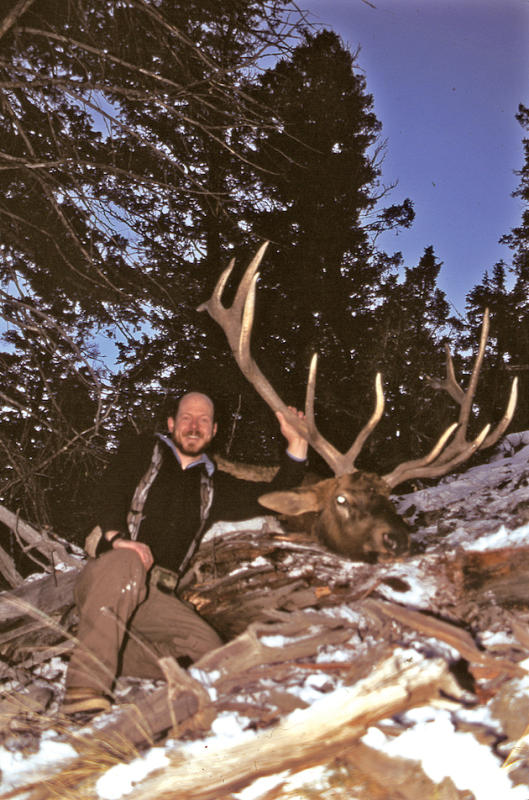
The author caught the beginnings of the Yellowstone migration one cold October morning and tagged this six-point on a bordering ranch.
For residents and nonresidents alike, much of the best trophy hunting comes only if you draw a limited entry permit. For each of the last 30 years I’ve applied in several states and managed to sort a few of these permits from the substantial pile of rejections.
The first premium chance I drew was a muzzleloader hunt for one of the top Arizona areas during the rut. I hunted with my late buddy, Les Shelton; his son, Levi; and guide Randy Bryant in an area just south of Flagstaff. Bulls were everywhere. We literally ran from bugle to bugle for several days until a heavy six-by-seven made a mistake. We had been after him for two hard hours before he was distracted by a cow and showed himself at 80 yards. The Barnes bullet penetrated both lungs and held together in the perfect “X,” one of the petals just visible through hair on the off side.
Several years later I drew Arizona again, this time the early rifle hunt in what is generally regarded as best area in the state. I didn’t sleep very much for four months, anticipating the greatest hunt of my life. The season lasted six days, and with outfitter John McClendon’s expert calling and Randy Bryant’s scouting, we looked at dozens of bulls that had stunted antlers from the record drought. Bulls that normally would have crowded 400 inches topped out at maybe 330. We never gave up and had a wonderful time, but I accounted for only three skinny coyotes.
A few more years passed, and I drew a second Arizona muzzleloader rut tag for a newly opened area. Naturally, I called McClendon again. Conditions for antler growth were ideal, with plenty of rain and feed all summer. We found the bull of my dreams on the third morning, an eight-point that would have taped somewhere above 415 before his right beam was snapped off just above the royal. We left him to another hunter who happened along, then force-marched two canyons over with high hopes of finding the owner of a beautiful, deep bugle we had heard in the distance. That bull would have scored high in the Boone & Crockett record book as a straight six-pointer had one of his 20-inch brow tines not been sheared off at the burr. He was, without question, the most beautiful bull I’d ever seen. I managed to laugh off the bad luck by the time camp showed itself in the headlights.
That night, John took a call from a local taxidermist who had seen a big elk at the other end of the unit. We made a long drive, posted high just before daylight, and John used his tripod-mounted binoculars to discover a distant bull. We watched him for a long time. After my mind was made up, John teased him in until I had a broadside shot. The eight-by-nine was the finest elk I’d yet to pack out of the woods.
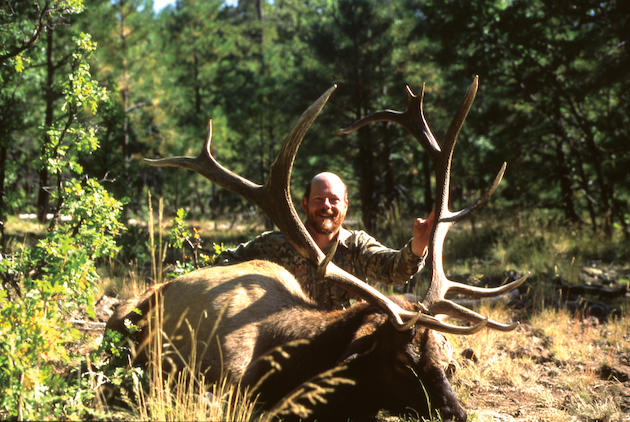
This heavy-bladed six-by-seven is the result of an Arizona muzzleloader permit timed to the rut.
As elk states go, Montana doesn’t offer many opportunities for really big bulls. There are few trophy units, and being lucky enough to draw a permit for one of them is the stuff of legends. Kellie and I recently pulled permits for the best unit of them all. That we did it in the same year made for one of the most amazing hunts I’ve ever experienced. The rifle season was six weeks long and we hit it hard from the first light of opening day.
Kellie connected halfway through the first week, taking a wonderful bull with 54-inch main beams. All the better, she did it with a single, perfect shot. Me? I hunted 23 days and counted nearly 150 branch-antlered bulls, although I’m sure some showed up more than once. I was holding out for something in the 390-class and saw three bulls that good or better. Two of them were broken up, so I let them pass. The best one of all was intact, but we never got closer than a mile. It was hard to have that season end, mostly because a hunt like that probably won’t come around again.
It isn’t much of a surprise that private land provides some of the best chances for big bulls, which usually comes at a price, though it is fair to say that hunting private land might be the best deal in the long run.
My biggest bull, a six-by-seven that goes 355 even though he’s only 28 inches wide, was taken on huge New Mexico ranch. Success aside, that hunt itself was just plain fun. I paired with outfitter Kirk Kelso, so it didn’t matter if we were closing in on bugling bulls, force-marching through the dark, or crawling up a steep slope while looking for a place sit and glass, we were laughing all the time. Kelso is a hunter’s hunter, and I would do this one all over again if it were possible, just to get another week around the fire with him.
While working for the Rocky Mountain Elk Foundation, one of my favorite responsibilities was putting together the world-record elk display for its annual convention. This allowed me to meet and hear stories from many of the hunters who had taken bulls at the very top of the record-book. Luck played the star in almost every instance.
A seasoned hunter working a steep canyon with his son tagged one of the largest elk taken in the last hundred years. The bull ran past his son first, offering him a shot. He let it go, as it was heading toward his father. Things worked out that day and the father shot the giant, a straight six that finaled just shy of 420. I hunted that same canyon with them several years later and saw a pair of absolutely enormous bulls, but we could never cut enough distance.
A meat hunter in Montana took my favorite nontypical bull. It was snowing hard, and he was driving up a skid trail with nothing more on his mind than filling the cow permit in his pocket. Spotting the south end of a bedded cow, he crept forward until its shoulder was clear and fired a single shot from his Winchester Model 88. About 424 inches of antler were attached to that cow.
Just over the mountain a couple of years before, one of his friends had gone out to get the winter’s meat. A lifetime ranching the same property taught him where elk were likely to be found. Finding a herd, he crept in on them and discovered a huge bull.
“I shot him because I figured he would consume twice as much grass as what a cow would eat,” he told me. “Wish I hadn’t. The meat was terrible and I gave most of it away.” The antlers sat on the floor in his calf barn for at least ten years before he agreed to let them be cleaned up and shared with the world. They crowd 430.
The wildest record-topping nontypical bull was taken in the Idaho Panhandle by a miner. Something went wrong at the mine one day so his shift was called off. Up and dressed anyway, he went hunting and the elk simply ran into him. Thankfully, it was close. He shot it a few times and then some more just for practice. The bull finally gave up.
Back home, he pulled the bullets from the reloaded cartridges bought on the cheap and weighed the powder charges. They varied by more than 20 grains! Some years later he sold the rack to an antler collector who put them to the tape. That bull scored 403.
My father had wanted to hunt elk most of his life, and several years after retiring decided to give it a try. He drew a Montana nonresident license the year he turned 70 and joined me for a hunt in the mountains near Missoula. Dad came in early for some preseason shooting practice with the Winchester Model 70 he bought me when I turned 13, and opening day found us wading thigh-deep snow in my favorite area hard on the Idaho border. The elk seem to have moved down already, but we pounded the trails for two days before pulling back to the house for a rest.
The next evening we climbed a steep hill not far away and surprised a herd with a lone spike bull. Dad’s first shot missed, but the next one dropped the bull, which rolled several hundred yards in what was thankfully the right direction. I will never forget the look on everyone’s face when we pulled in that night with a Jeep full of elk. Dad is 95 now, and we still enjoy admiring those antlers while recalling that hunt.
When she was just 15, my daughter used up her lifetime supply of hunting luck in a single day. Keni had never taken a big game animal in North America and was determined to put that to rest. Long before daylight on opening morning, we shouldered packs and started up a closed road that snaked through a few likely sections of public land.
At first light, we surprised a wonderful nine-point whitetail buck standing in some Christmas trees and her shot was spot on. We dragged him into an opening and waited for the sun to top the Swan Mountains so the pictures would turn out just right.
Celebrating the moment, we talked loudly and never gave another opportunity a second thought. Family tradition calls for everyone to dress their own game, so I presented her with a knife I had carried in my pack for three years in anticipation of this day. Just as she was making the first cut, a bull bugled from the timber below. Thirty minutes later she was tying her tag to a big six-by-six elk that dropped to her single shot. She then matched me pack-for-pack, and we managed to have the truck full of quarters, capes, and heads just before dark. We had quite a time at the game check station. A couple of officials doubted her story, but it all worked out. I wasn’t much surprised when several marriage proposals came her way in the following days.
For many hunters, elk is the biggest of big game and the most difficult hunt they will ever attempt. It might also be the only time an outfitter will be considered or a nonresident application gets submitted. With so many choices, it really pays to have an expert working your corner.

Idaho miner Fred Scott shot his non-typical on an unexpected day off from work. Photo courtesy of the Boone and Crockett Club.
Jack Atcheson Jr., and brother Keith of Atcheson and Sons (atcheson.com) have probably put more elk hunters together with outfitters than any other booking agency, and many of their hunts do not require drawing a permit. I’ve worked with these guys for years and every suggestion they have ever made has been blue chip.
John McClendon (jmac@cactusbull.com), Aaron Neilson (globalhuntingresources.com), Huntin’ Fool (huntinfool.com) and Cabela’s (cabelas.com)—all have hunter application services that will point you in the right direction. They will assist with applications in most of the elk states after consulting about the options and can even recommend a good outfitter if you draw and then decide not to make the hunt on your own.
One of the best ways to judge the professional commitment of a potential outfitter is finding out if they give back to the resource. The Rocky Mountain Elk Foundation publishes a list of member outfitters in every issue of their great Bugle Magazine. To join the foundation and get the magazine, visit rmef.org.
Make no mistake, once elk hunting gets in your blood it will stay with you forever. In 1984 I helped out in the fledgling Rocky Mountain Elk Foundation’s booth at a sports show in Spokane, Washington. To promote the show, the foundation had borrowed for display what was then the second largest bull in the record book, one scoring more than 440 points. Several local TV stations featured that bull on the news the night before the show started.
As the doors opened I noticed an old man standing in the cold spring rain at one of the box office windows, slowly counting out dollar bills for admission. Bracing himself with a cane in each hand, he came into the hall and shuffled his way to our booth. Once there, he leaned hard on the table, looked at that big elk for a very long time, then turned away, and slowly hobbled toward the exit.
I caught up to him, asking if I could be of help. He looked me over carefully, then said “I shot an elk like that, long before you were born. Didn’t have a place to put the horns and eventually lost track of them. I’ve always wondered if he was number one.”
“That must have been some elk,” I managed. “You think that one is yours?”
“Not sure,” he said turning toward the door. “Maybe.”
I sure wish he would have shared his story, one elk hunter to another.
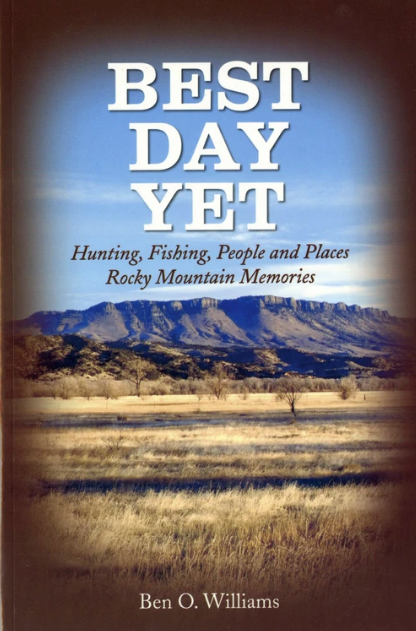 This book is a collection of the author’s true-shared essays of outdoor activities and of the folks he has encountered on the Great High Plains. It’s Ben’s Rocky Mountain Memories of hunting, fishing, people and places. This book has a far wider appeal than just for the hunting and fishing audience. No matter where you live, or what age, or in what walk of life you live, one of these essays will revive your memory of an experience in some way you had or someone in your family has handed down to you.
This book is a collection of the author’s true-shared essays of outdoor activities and of the folks he has encountered on the Great High Plains. It’s Ben’s Rocky Mountain Memories of hunting, fishing, people and places. This book has a far wider appeal than just for the hunting and fishing audience. No matter where you live, or what age, or in what walk of life you live, one of these essays will revive your memory of an experience in some way you had or someone in your family has handed down to you.
The stories are all vintage Ben; his writing is honest, heartfelt, always intends to be instructive, and is simply fun to read. They are not about killing things or hook and bullet stuff. These essays are about appreciating the land, enjoying the chase with his bird dogs, fly-fishing, conversations with outdoor folks and kicking gravel with landowners. Then, after each one of Ben’s stories there is a vignette, written by one of his many outdoor friends. Best Day Yet is an attitude that Ben created for himself. It’s how he feels about things according to his sense of the world around him. It’s like sitting by a mountain lake after a wonderful day of fishing with a flask of cheap blended scotch whiskey and believing an airplane dropped a fine 30-year-old single malt scotch whiskey that just drifted to shore at the exact spot where he was camping. His partner sitting next to him says, “What do you think of the whiskey?” “That’s one fine scotch.” Buy Now

